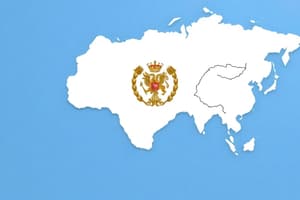Podcast
Questions and Answers
What are the two main types of sovereignty?
What are the two main types of sovereignty?
- Internal and External (correct)
- Political and Economic
- Physical and Digital
- National and International
The Peace of Westphalia marked the beginning of the modern nation-state system.
The Peace of Westphalia marked the beginning of the modern nation-state system.
True (A)
What is the key characteristic of a state?
What is the key characteristic of a state?
Sovereignty
The concept of the state's monopoly on the legitimate use of force within its territory is known as ______ sovereignty.
The concept of the state's monopoly on the legitimate use of force within its territory is known as ______ sovereignty.
Which of the following is NOT a characteristic of a state?
Which of the following is NOT a characteristic of a state?
Match the following concepts to their definitions:
Match the following concepts to their definitions:
The rise of the nation-state was primarily driven by economic factors.
The rise of the nation-state was primarily driven by economic factors.
Explain the phrase "War made the state and the state made war." What does this mean?
Explain the phrase "War made the state and the state made war." What does this mean?
Flashcards
State
State
A defined territory with a population governed by a national government with sovereignty.
Sovereignty
Sovereignty
The right of a state to exercise independent authority within its territory.
Internal Sovereignty
Internal Sovereignty
The state's control over the legitimate use of physical force within its territory.
External Sovereignty
External Sovereignty
Signup and view all the flashcards
Thirty Years' War
Thirty Years' War
Signup and view all the flashcards
Peace of Westphalia
Peace of Westphalia
Signup and view all the flashcards
Bellicist Argument
Bellicist Argument
Signup and view all the flashcards
Rise of Nationalism
Rise of Nationalism
Signup and view all the flashcards
Study Notes
Defining a State
- A state possesses a defined territory, marked by borders and lines.
- It has a defined population, often within state lines.
- A national government, exercising both internal and external sovereignty, governs the state.
Sovereignty
- Sovereignty is a state's right to govern itself independently within its borders.
- Internal sovereignty (empirical statehood) describes a state's monopoly on legitimized force within its territory. Government and police have the authority to rule and enforce order. Citizens do not have this right.
- External sovereignty (diristical statehood) is a state's right to conduct its affairs independently from external interference or pressure from other states.
Origins of the State
-
The Protestant Reformation and Thirty Years' War (1618-1648) are pivotal historical events.
-
Martin Luther's 95 Theses (1517) challenged the Catholic Church, initiating religious conflicts.
-
These conflicts escalated, involving secular rulers for their own interests.
-
The Peace of Westphalia (1648) significantly altered the political landscape.
-
It legitimized states as supreme authorities with internal and external sovereignty, establishing control over their people and territories.
- Independent domestic policies, like religious rules, became permissible, free from external interference.
State Success and Spread
- Charles Tilly's argument, "War made the state and the state made war," suggests successful states were efficient at war.
- These states maintained standing armies, centralized administrations, and efficient tax collection systems.
- This facilitated their survival compared to competing political organizations like tribes or city-states.
- The sovereign state model expanded globally, driven by modernization, imperialism, and trade.
- Nationalism further fueled this expansion, advocating for distinct nations within their own states.
- The 19th and 20th centuries witnessed dramatically increased state numbers, especially post-World War II.
Studying That Suits You
Use AI to generate personalized quizzes and flashcards to suit your learning preferences.




